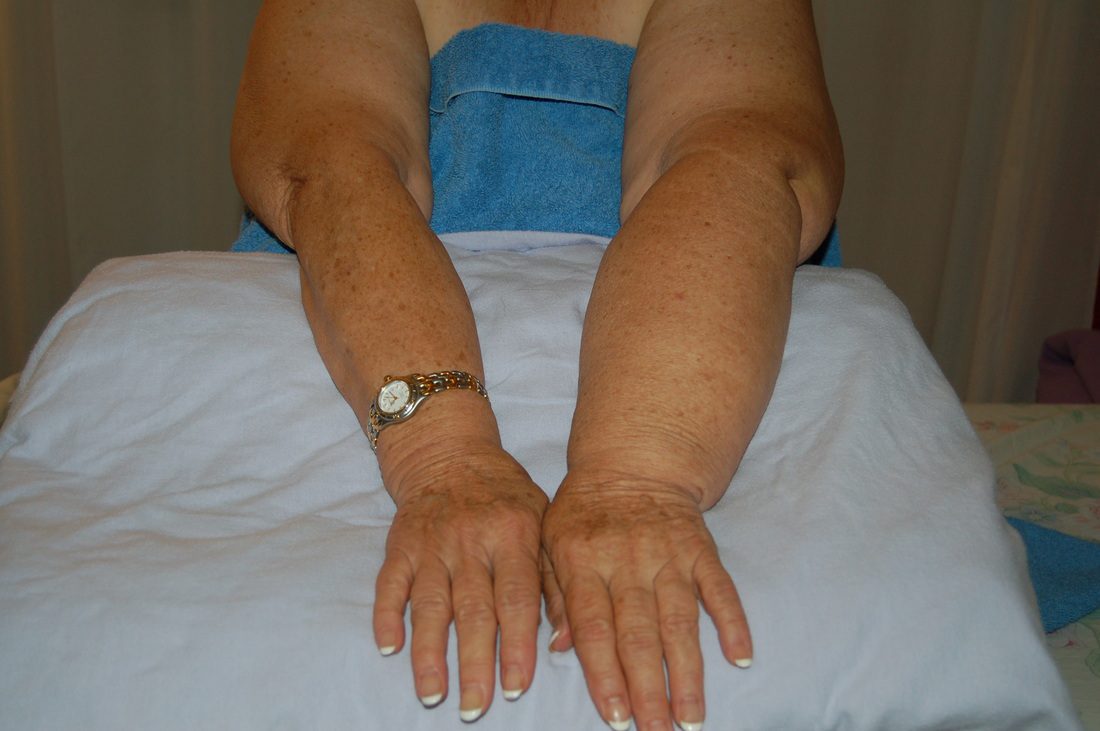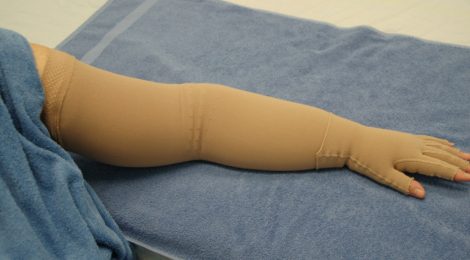What is Lymphedema?

Lymphedema is an accumulation of lymphatic fluid in the interstitial tissue that causes selling, most often in the arm(s) and/or leg(s) and occasionally in other parts of the body. Lymphedema can develop when lymphatic vessels are missing or impaired (Primary Lymphedema) or when they are damaged or when the lymph nodes are removed (Secondary Lymphedema).
What causes Lymphedema?
Primary Lymphedema is from unknown cause and can be present at birth, develop on the onset of puberty (Praecox) or in adulthood (Tarda). It can affect from one to as many as four limbs and/or other parts of the body.
Secondary Lymphedema or acquired Lymphedema, can develop of a result of surgery, radiation, infection or trauma. Specific surgeries which require removal of lymph nodes such as surgery from melanoma or breast, gynecological, head and neck, prostate or testicular, bladder or colon cancer put patients at risk of developing secondary ymphedema. If lymph nodes are removed, then there is always a risk of developing lymphedema.
Secondary lymphedema can develop immediatly post-operatively or weeks, months and even years later. Aircraft flight has also been linked to the onset of lymphedema in patients post cancer surgery likely due to decrease in cabin pressure).
The use of Tamoxifen can cause blood clots and subsequent Deep Venous Thrombosis or DVT.
Radiation can damage otherwise healthy lymph nodes and vessels; ,causing scar tissue to form which in turn interrupts the normal flow of the lymphatic fluid. It is important to closely monitor the radiated area for any skin changes such as increased temperature, discoloration (erythema) or blistering which can all lead to the development of lymphedema.
Lymphedema can develop secondary to lymphangitis (infection) which interrupts normal lymphatic pathway function.
A severe traumatic injury in which the lymphatic system is interrupted and/or damaged in any way also triggers the onset of lymphedema.
Symptoms of Lymphedema
Lymphedema can develop in any parts of the body or limbs. Signs or symptoms of Lymphedema include: . Skin feeling tight . Decreased flexibility in the hand, wrist or ankle . Difficulty fitting into clothing into one specific area . Ring, wristwatch, bracelet tightness If you notice persistent swelling, it is important that you seek immediate medical advices as an early diagnosis and treatment improve booth the prognosis and the condition.
Lymphedema develops in a number of stages from mild to severe,referring to Stage 1, 2 and 3.
Stage 1 (Spontaneously reversible): The tissue is still at the “pitting” stage, which means that when pressed by fingertips the area indents and holds the indention. usually upon waking in the morning, the limb (s) or the affected area (s) is normal or almost normal size.
Stage 2 (Spontaneously irreversible): The tissue now has a spongy consistency and is “non pitting”, meaning that when pressed by fingertips, the tissue bounces back without any indentation forming. Fibrosis found in Stage 2 Lymphedema marks the beginning of the hardening of the limb (s) and increasing size.
Stage 3 (Lymphostatic elephantiasis): At this stage, the swelling is irreversible and usually the limb(s) is/are very large. The tissue is hard (fibrotic) and unresponsive.
When the lymphedema remains untreated, protein-rich fluid continues to accumulate, leading to an increase of swelling and a hardening or fibrosis of the tissue. In this state, the swollen limb(s) becomes a perfect culture medium for bacteria and subsequent recurrent lymphagitis (infections). Moreover, untreated lymphedema can lead into a decrease or loss of functioning of the limb(s), skin breakdown, chronic infections and sometimes irreversible complications.
Signs and symptoms of Lymphangitis (infection) may include some or all of the following: rash, red/bltochy skin, itching of the affected area, discoloration, increasedswelling and /or temperature of the skin, heavy sensation in the limb (more so than usual), pain and in many cases a sudden onset of high fever and chills.
Treatment for infections: immediately discontinue ALL current lymphedema treatment modalities (including Manual Lymphatic Drainage, Bandaging, Pumps, wearing of Compression Garments) and contact your Physician as soon as possible. The antibiotics of choice for these types of lymphatic infections are those in the Penicillin family.
Note: ALWAYS carry antibiotics or a prescription with you when you travel
Lymphangitis = Infection = Cellulitis = Erylepsis
How is Lymphedema treated?
Since there is no cure of lymphedema, the goal of the lymphedema treatment is to reduce the swelling and maintain the reduction. The is best achieved by the skillful application of Complete Decongestive Therapy or CDT – a non invasive, safe and reliable method that shows good, long term results in both Primary and Secondary Lymphedema


